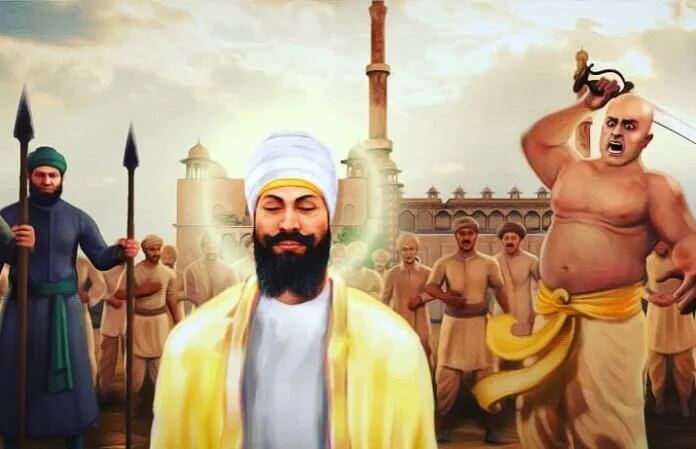
Born in Amritsar, Punjab in 1621 Guru Tegh Bahadur was the youngest son of Guru Hargobind the sixth Sikh guru and ninth of ten Sikh Gurus. He is said to have been originally called Tyag Mal but was later renamed as Tegh Bahadur meaning “Mighty of Sword” because of his gallantry deeds in the wars against the Mughal.
He was known to be a fearless warrior and learned scholar who contributed several hymns which were included in the Sri Guru Granth Sahib.
Brought up in the Sikh culture and traditions, he was also trained in archery and horsemanship. He was also taught the Vedas, Upanishads, and Puranas.
Guru Tegh Bahadur was married to Mata Gujri on 3 February 1632.
In the 1640s, his father Guru Hargobind and mother Nanki shifted to their ancestral village — Bakala a prosperous town in Amritsar district. Tegh Bahadur and Mata Gujri accompanied them and continued to live there even after Guru Hargobind’s death.
In March 1664 Guru Har Krishan contracted smallpox. He was on his death bed when his followers asked him where his successor was to be found, he replied Bakala. Taking advantage of the ambiguity many claimants sprung up in Bakala, claiming themselves to be the new Guru.
There is an interesting story how Tegh Bahadur was finally selected as the ninth guru. It is said that a wealthy trader, Baba Makhan Shah Labana had once promised to give 500 gold coins to the Sikh Guru if he survived. So after Guru Har Krishan’s death, he landed up in Bakala to search for the ninth Guru. But since there were so many claimants he devised a plan and offered two gold coins to each Guru, who quietly pocketed the two coins and het him go. Labana was disappointed because he knew in his heart, that only the real Guru would know that he had promised to pay 500 coins.
Finally he came to know that Tegh Bahadur also lived at Bakala. So as usual, he offered two gold coins to Tegh Bahadur who gave him his blessings and asked him why he was not paying the five hundred coins that he promised to pay. Labana’s joy knew no bounds, he immediately paid the difference and ran outside shouting from the rooftop, “Guru ladho re, Guru ladho re” meaning “I have found the Guru, I have found the Guru”.
Finally a Sikh Sangat arrived in Bakala and anointed Tegh Bahadur as the ninth Sikh guru.
Tegh Bahadur lived an austere life and contributed 116 shabads, and 15 ragas which are included in the Guru Granth Sahib (pages 219–1427). This is apart from his teachings on a wide range of topics, such as the nature of God, human attachments, body, mind, sorrow, dignity, service, death, and deliverance which are part of the bani in Sikhism.
Also Read: Guru Granth Sahib: the spiritual guide and eternal Guru
Guru Tegh Bahadur traveled extensively in different parts of the country to preach the teachings of Nanak, the first Sikh guru. The places he visited and stayed have become sites of Sikh Gurdwaras.
Some of the most significant initiatives of Guru Tegh Bahadur include langars and water tanks – to feed anyone who is hungry or thirsty.
Guru Tegh Bahadur founded the city of Anandpur Sahib in the foothills of Himalayas.
Guru Tegh Bahadur attracted a large number of followers who used to accompany him as when he moved from place to place.
There are conflicting opinion about how Guru Tegh Bahadur’s death. According to some, his body was cut into four parts on the orders of Aurangzeb and hung at the four gates of the Gwalior fort.
However according to another version, Guru Tegh Bahadur was arrested at Ropar and brought to Delhi by the Mughal officials who asked him to perform a miracle to prove his nearness to God or convert to Islam. When the Guru declined, three of his devotees Bhai Mati Dass, Bhai Sati Das and Bhai Dayala were tortured to death in front of him. Bhai Mati Das was sawn into pieces, Bhai Dayala was thrown into a cauldron of boiling water, and Bhai Sati Das was burned alive. Thereafter, Tegh Bahadur was publicly beheaded on the orders of Aurangzeb, the sixth Mughal emperor at Chandni Chowk near the Red Fort.
After his death Gurdwara Sis Ganj Sahib was built at Chandni Chowk where he was beheaded while the residence of a disciple who burned his house to cremate Guru Tegh Bahadur’s body in Delhi is now called Gurdwara Rakab Ganj Sahib.
Even today his martyrdom is observed as the Shaheedi Divas according to the Nanakshahi calendar on 24 November, every year.
Guru Tegh Bahadur is also known as Hind-di-Chaadar (shield of India) for resisting the forced conversions of Hindus to Islam in Kashmir. He thus became the first person in history to sacrifice his life to save the followers of another religion.
After his death, his son Gobind Singh went on to be the tenth and last Sikh Guru.

